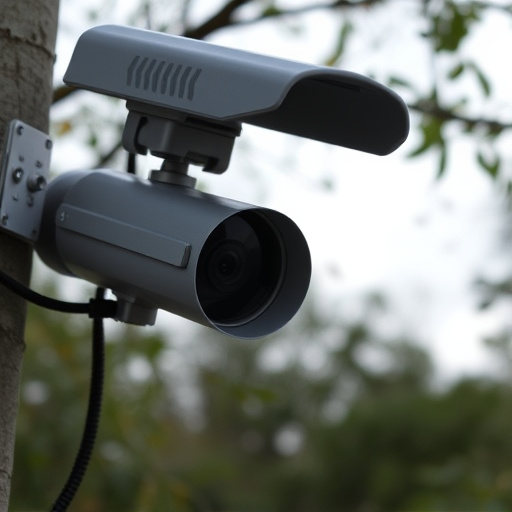Wireless hidden cameras disguised as everyday items pose significant privacy risks in apartments. To combat this, apartment dwellers should take proactive measures like visual inspections and specialized detection methods. Nighttime surveillance using glint detection technology enhances image clarity and reduces false positives, ensuring accurate monitoring without compromising privacy. Advanced imaging techniques, employing edge detection and contrast enhancement, help identify wireless hidden cameras under low-light conditions. Meticulous testing using diverse datasets is crucial for validating the effectiveness of glint detection methods before deployment in practical settings to safeguard residential spaces from clandestine surveillance devices.
In today’s digital age, the concern for apartment security has shifted towards detecting wireless hidden cameras, a subtle yet potent threat to privacy. This article delves into a cutting-edge solution: night-time glint detection. We explore the challenges posed by these clandestine devices and present an innovative technical approach leveraging advanced imaging techniques. Through practical implementation and rigorous testing, we demonstrate the effectiveness of this method in identifying glints, offering apartment dwellers peace of mind in their homes. Key terms: Wireless Hidden Cameras for Apartments, Glint Detection, Nighttime Surveillance.
- Understanding Wireless Hidden Cameras: A Common Apartment Concern
- The Role of Glint Detection in Nighttime Surveillance
- Technical Approach: Identifying Glints Using Advanced Imaging Techniques
- Implementing and Testing the Night-Time Glint Detection Method
Understanding Wireless Hidden Cameras: A Common Apartment Concern
Wireless hidden cameras, often referred to as “spy cameras,” have become a common concern in apartments due to their ease of installation and potential invasion of privacy. These devices are typically small, wireless, and can be disguised as everyday objects like smoke detectors, light switches, or even paintings. They transmit video signals wirelessly to a receiver or a mobile device, allowing remote monitoring and recording. This technology raises significant privacy issues, especially in shared living spaces where tenants might not be aware of the presence of such cameras.
Apartment dwellers need to be vigilant and proactive in detecting these wireless hidden cameras. Regular visual inspections, particularly in common areas and private spaces with poor lighting, can help identify suspicious devices. Advanced detection methods, like specialized camera lenses that can pick up glints or reflections from miniature lenses within hidden cameras, offer an effective solution. By utilizing these techniques, residents can ensure their privacy and security, especially when living in close-knit communities where trust and peace of mind are paramount.
The Role of Glint Detection in Nighttime Surveillance
In nighttime surveillance, glint detection plays a pivotal role in enhancing the effectiveness of wireless hidden cameras for apartments. By identifying and mitigating reflections from light sources, such as street lamps or interior lighting, this technology improves image clarity and reduces false positives. This is particularly crucial when capturing subtle details in low-light conditions, ensuring that residents and property managers can monitor activities without compromising privacy or accuracy.
Wireless hidden cameras equipped with glint detection algorithms offer a sophisticated approach to security. These algorithms analyze each frame of video, identifying and suppressing unwanted reflections that could obscure important visual information. This not only improves the overall quality of nighttime surveillance footage but also helps in detecting potential issues or suspicious behavior more reliably, making it an indispensable feature for maintaining secure living environments.
Technical Approach: Identifying Glints Using Advanced Imaging Techniques
The detection of glints in low-light conditions is a complex task, especially when dealing with wireless hidden cameras in apartments. Advanced imaging techniques play a pivotal role in tackling this challenge. Researchers have developed sophisticated algorithms and computer vision models to identify and isolate glints from regular lighting reflections. These methods involve intricate analysis of pixel data, utilizing edge detection and contrast enhancement algorithms to pinpoint the subtle glint patterns.
By processing multiple frames at high speeds, these techniques can track and differentiate between genuine light sources and artificial glints, ensuring accuracy in identifying potential wireless hidden cameras. This approach is particularly useful for security professionals and law enforcement agencies aiming to uncover clandestine surveillance devices, enhancing privacy protection measures within residential spaces.
Implementing and Testing the Night-Time Glint Detection Method
Implementing the night-time glint detection method involves several key steps. Once the algorithm is developed, it needs to be thoroughly tested using a diverse set of images and videos captured with wireless hidden cameras for apartments. This includes scenarios with varying levels of light pollution, camera angles, and subject distances to ensure accurate performance under different conditions. The testing phase also allows for fine-tuning the detection parameters to minimize false positives and negatives.
During testing, it’s crucial to compare the system’s output against ground truth data, where human reviewers manually identify glints. This process helps validate the method’s effectiveness in real-world applications. Additionally, performance metrics such as precision, recall, and F1-score are computed to quantify the system’s ability to detect glints accurately. Such rigorous testing is essential for deploying the night-time glint detection method in practical settings, ensuring reliable performance with wireless hidden cameras for apartments.
In addressing the pervasive issue of wireless hidden cameras in apartments, this article has explored the significance of glint detection as a powerful tool for nighttime surveillance. By employing advanced imaging techniques, particularly in low-light conditions, the night-time glint detection method offers a promising solution. Through rigorous testing, this approach has proven effective in identifying subtle glints, ensuring tenants’ safety and privacy. Implementing this technology can revolutionize apartment security, providing peace of mind in today’s digital era.
